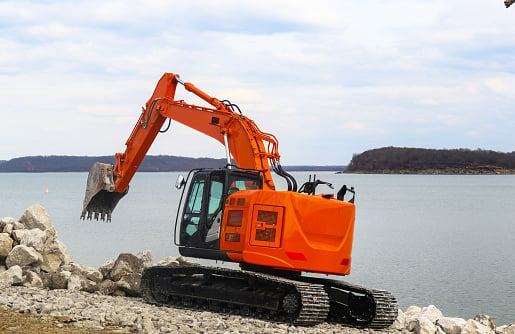
Gravel is an inexpensive paving material overall, but costs vary by type. Find out what average gravel prices will look like for your project.


The amount of rip rap you need depends on the volume of the area you need it to fill.
Rip rap is typically measured in tons, with different classes suited to various slope grades.
Use our rip rap calculator to determine the volume and convert it to tons.
A professional landscaping company can help measure for and install rip rap.
If you’re staring down an eroded shoreline or a slope that’s seen better days, calculating the right amount of rip rap you need can help your project stay grounded—literally. Whether you’re an experienced excavator or just want to double-check your contractor, our rip rap calculator can help you crunch the numbers without losing your footing—or your savings.
You can’t calculate rip rap without considering the length, width, and depth of the space it will fill. Here’s a look at how many tons of rip rap you can expect to have installed based on your measurements.
| Length (Feet) | Width (Feet) | Depth (Feet) | Volume | Tons of Rip Rap Needed |
|---|---|---|---|---|
| 20 | 5 | 2 | 7.4 | 11.1 |
| 40 | 6 | 2 | 17.8 | 26.2 |
| 60 | 8 | 2 | 35.6 | 53.3 |
| 100 | 10 | 2 | 74.1 | 111.1 |
To determine how many tons of rip rap you need, you’ll need to first calculate the volume of the rip rap needed in cubic yards, then convert cubic yards to tons. Start with the first calculation, then multiply the volume in cubic yards by 1.5 to determine the number of tons of rip rap you need.
Volume (cubic yards) = ((Length (feet) x Width (feet) x Depth (feet)) ÷ 27)
Tons of rip rap needed = Volume (cubic yards) x 1.5
Rip rap comes in different size classes defined by the diameter of the stones. The chart below shows the different classes of rip rap based on size and what type of structure the rip rap is best used for.
| Class | Stone Diameter (Inches) | Best Used For |
|---|---|---|
| A | 2–6 | Small drainage ditches |
| B | 4–8 | Moderate slopes, small channels |
| C | 6–12 | Steeper slopes |
| D | 12–18 | Heavy-duty shoreline protection |

Rip rap can be installed by a number of professionals, so long as they have experience in erosion control and shoreline stabilization. Consider hiring the following experts to take on this not-so-small task:
This type of specialist often handles grading, drainage, and shoreline work using heavy machinery to place and move large rocks.
If you live near a lake, river, or ocean, a waterfront contractor is your go-to for projects located on coasts or near shorelines. They often specialize in docks, seawalls, and rip rap installation.
Make sure to specify that you’re looking for a landscaping company with hardscaping experience since you’ll need experts who have a background in erosion control. The company you hire will need to be on the larger side, as you’ll require a whole crew and the right equipment to handle rip rap.
Although they may not be the ones installing your rip rap, a civil or environmental engineering firm can help design the rip rap placement, obtain the correct permits, and recommend trusted installers to bring their plans to life.
From average costs to expert advice, get all the answers you need to get your job done.

Gravel is an inexpensive paving material overall, but costs vary by type. Find out what average gravel prices will look like for your project.

Discover the average forestry mulching cost, including per-acre and hourly rates, plus key factors that impact your total price. Get expert tips to save on your project.

Find out the average mulch delivery and installation cost, plus key factors that impact your price. Learn how to budget, compare options, and save on your landscaping project.

From wood chips to grass clippings, we like to throw around the word mulch. But what is mulch, and how do you use it properly? Let's break it down.

Explore a guide to mulch versus rock landscaping. Uncover the pros, cons, costs, and more to shape a garden mirroring your style and landscaping needs.

Whether you should remove old mulch depends on your unique situation and personal preferences. Learn more about how to handle last season’s spread.